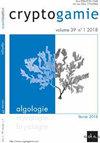南乌拉尔地区陆生蓝藻的生物多样性
IF 1.5
4区 生物学
Q3 MARINE & FRESHWATER BIOLOGY
引用次数: 9
摘要
南乌拉尔是一个地理位置独特、自然条件异质的地区。该地区未开发的陆生蓝藻生物多样性非常高。我们进行了一项植物区系研究,涵盖车里雅宾斯克州巴什基里亚和布列金斯基区的所有植物地理区。在总共收集的85个土壤样本中,鉴定出56种蓝藻。蓝藻数量以寒带林带最多(39种),其他带最少(阔叶林、森林草原和草原区分别为18种、29种和24种)。在所有研究区均检出沃氏细绒蚧、中心细绒蚧、医院毛蚧、hollerbachianpseudophormidium hollerbachianum、斑点状褐孔蚧、阴道细绒蚧、短绒蚧、二绒蚧、长绒蚧和细绒蚧。在森林带发现变异毛霉和大柱孢,在森林-草原和草原带发现典型的桔梗草,在草原带发现最多的是hollerbachianum和Nostoc c.c orco . commune。湿度和基质的异质性可能是影响陆生蓝藻多样性的最重要因素。为了充分了解南乌拉尔蓝藻的生物多样性,未来的分子遗传学研究是必要的。本文章由计算机程序翻译,如有差异,请以英文原文为准。
Biodiversity of Terrestrial Cyanobacteria of the South Ural Region
Abstract South Ural is a territory with a unique geographical position and heterogeneous natural conditions. Unexplored biodiversity of the terrestrial cyanobacteria of this territory is very high. We undertook a floristic study covering all botanical-geographical zones of the Bashkiria and Bredinskiy district of the Chelyabinsk region. In a total of 85 soil samples collected, 56 species of cyanobacteria were identified. The number of cyanobacteria was highest in the boreal-forest zone (39 species) and notably lower in the other zones (18, 29, and 24 species for broad-leaved forest, forest steppe and steppe regions, respectively). Leptolyngbya voronichiniana, Leptolyngbya foveolarum, cf. Trichocoleus hospitus, Pseudophormidium hollerbachianum, Nostoc cf. punctiforme, Microcoleus vaginatus, Phormidium breve, Phormidium dimorphum, Phormidium corium, and Leptolyngbya cf. tenuis were detected in all studied zones. Trichormus variabilis and Cylindrospermum majus were detected in the forest zone, Phormidium ambiguum was typical for forest-steppe and steppe zones, Pseudophormidium hollerbachianum and Nostoc cf. commune were most abundant in the steppe. Humidity and heterogeneity of the substrate were likely the most important factors influencing terrestrial cyanobacteria diversity. For full understanding of the biodiversity of cyanobacteria in the South Urals, future molecular-genetic research is necessary.
求助全文
通过发布文献求助,成功后即可免费获取论文全文。
去求助
来源期刊

Cryptogamie Algologie
生物-海洋与淡水生物学
CiteScore
2.60
自引率
7.70%
发文量
11
审稿时长
>12 weeks
期刊介绍:
Cryptogamie is a fast-track and peer-reviewed journal of international scope publishing in English only. It accepts original papers and review articles on the taxonomy, biology and ecology of all cryptogams. An issue of Cryptogamie may be devoted to a single topic, under the responsibility of guest editor(s). All articles published in Cryptogamie are compliant with the different nomenclatural codes. A copyright assignment will be signed by the authors before publication.
Cryptogamie, Algologie accepts articles on systematics as well as ecology and evolution of any kind of algae (including Cyanobacteria).
 求助内容:
求助内容: 应助结果提醒方式:
应助结果提醒方式:


